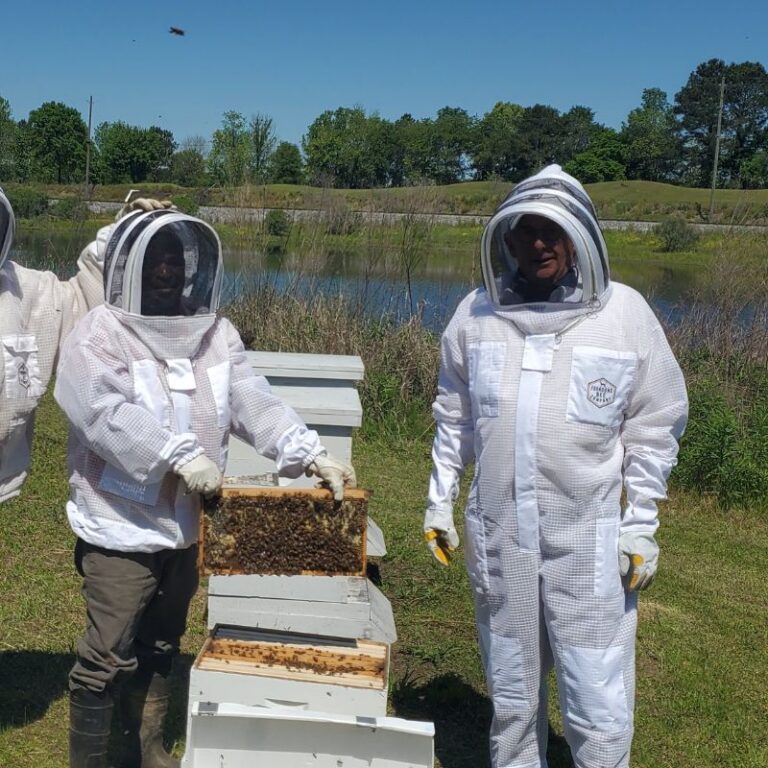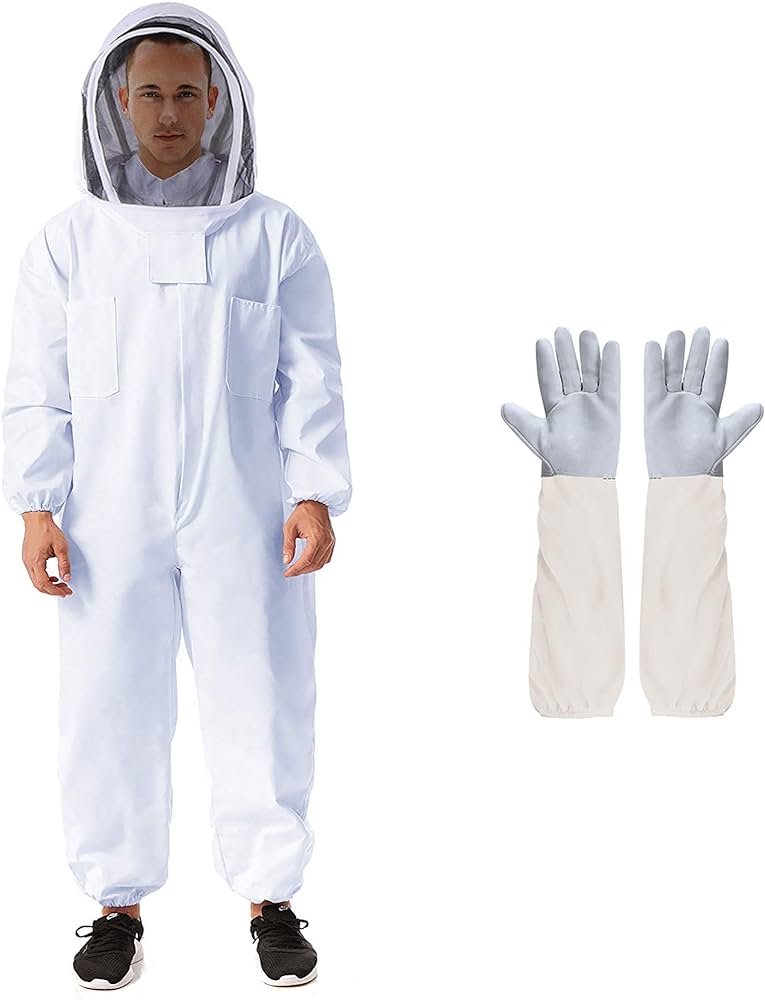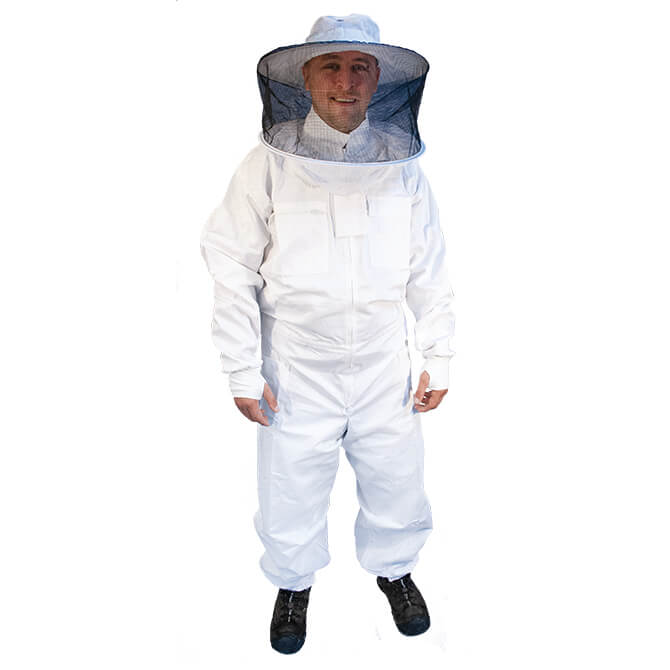
Essential Guide to Beekeeping Suits: Protecting Yourself from Bee Stings
I. Unveiling the Buzz: A World of Honey and Potential Ouch!
(A) The world of beekeeping is experiencing a surge in popularity, captivating individuals with its promise of connection to nature, sustainable practices, and the delicious reward of golden honey. However, for aspiring beekeepers, the prospect of working with bees can be both exciting and intimidating. One of the most significant concerns? Bee stings.
(B) This is where beekeeping suits come in, playing a crucial role in safeguarding beekeepers from the potential discomfort and pain of bee stings. A proper beekeeping suit acts as a protective barrier, allowing beekeepers to confidently inspect their hives, perform maintenance tasks, and enjoy the beekeeping experience without fear of getting stung.

II. Understanding the Sting: A Tiny Spear with a Powerful Punch
(A) Before diving into the world of beekeeping suits, let’s understand the potential threat they protect against: the bee sting. A bee stinger is a complex, barbed structure located at the end of a bee’s abdomen. When a bee feels threatened, it uses its stinger to inject venom, a cocktail of chemicals designed to defend the hive.
(B) Bee venom contains several components that can trigger an inflammatory response at the sting site, causing localized pain, redness, swelling, and itching. In rare cases, individuals can experience severe allergic reactions to bee stings, requiring immediate medical attention. Understanding the potential consequences of a bee sting highlights the importance of proper protection during beekeeping activities.

III. Your Suit of Armor: Essential Components for Beekeepers
(A) Now, let’s delve into the essential components of a beekeeping suit, your first line of defense against bee stings. Typically, a beekeeping suit consists of a jacket, pants, a hood with a veil attached, and elasticated cuffs and ankles for a secure fit.
(B) The material of the suit plays a vital role in its effectiveness. Ventilated bee suits, often made of mesh or cotton, prioritize breathability and comfort in warm weather. Heavy-duty bee suits, constructed from canvas or denim, offer enhanced protection for beekeepers working with aggressive bee species or encountering potential hazards like rough terrain around the hive.

IV. Tailoring Your Protection: Different Types of Beekeeping Suits
(A) With various beekeeping suit options available, selecting the right one depends on your individual needs and preferences. Here’s a closer look at some common types:
(B) Ventilated Bee Suits: These lightweight suits prioritize airflow and comfort, making them ideal for beekeeping in warm weather or for beekeepers who tend to sweat easily. Look for suits with well-ventilated mesh panels on the jacket, pants, and veil.
(C) Hooded Bee Suits: These suits offer full head and neck protection with a veil attached to the hood. The veil, typically made of mesh, allows beekeepers to see clearly while keeping their face and head shielded from stings.
(D) Heavy-Duty Bee Suits: Designed for beekeepers working with aggressive bee species or encountering potential hazards, these suits are constructed from thicker, more durable materials like canvas or denim. They may also feature additional padding on the arms and legs for enhanced protection.

V. Choosing the Right Suit: Finding Your Perfect Fit
(A) With various beekeeping suit options available, selecting the right one requires careful consideration. Firstly, assess your experience level. If you’re a beginner, opt for a comfortable, well-ventilated suit that allows for easy movement. As you gain experience, you can explore more specialized options.
(B) Secondly, consider the climate in your area. For hot summers, a ventilated mesh suit is ideal. For cooler climates, a heavier suit with minimal mesh panels might be more comfortable. Budget is another factor to consider, with ventilated suits generally being more affordable than heavy-duty options.
VI. A Look at Popular Choices: Comparing Beekeeping Suits
(A) To help you navigate the selection process, here’s a comparative review of some popular beekeeping suits:
(B) Flow Bee Suit:* This lightweight, mesh bee suit prioritizes comfort and breathability. It’s a good choice for beginner beekeepers or beekeepers in warm climates.
(C) Mann Lake Professional Beekeeping Suit:* This heavy-duty suit, constructed from durable cotton, offers excellent protection against bee stings. It’s ideal for beekeepers working with aggressive bee species.
(D) Beekeeper’s Friend Deluxe Beekeeping Suit:* This versatile suit features a removable veil and interchangeable mesh and solid fabric panels, allowing for customization.
(E) Hardin Beekeeping Suit with Fencing Veil:* This suit boasts a ventilated jacket and pants with a full fencing veil for optimal head and neck protection. It’s a good choice for beekeepers who prioritize both comfort and visibility.

VII. Beyond the Suit: Essential Gear for Complete Protection
(A) While a beekeeping suit is crucial, it’s not the only protective gear beekeepers need. Here are some additional items to consider:
(B) Beekeeping Gloves:* Bee stings on the hands can be particularly painful. Invest in high-quality beekeeping gloves made from a durable, sting-resistant material with long cuffs that extend under the sleeves of your bee suit for added protection.
(C) Beekeeping Boots:* Protect your feet and ankles from stings with sturdy beekeeping boots. Look for boots made from leather or rubber with good traction to navigate the apiary safely.
(D) Smoker:* A smoker is a tool used to puff smoke into the hive during inspections. Smoke disrupts the bees’ communication system, making them less defensive and easier to manage. While not essential for every inspection, a smoker can be a helpful tool for some beekeepers.
VIII. Maintaining Your Beekeeping Suit: Keeping Your Armor in Top Shape
(A) Your beekeeping suit is an investment, so proper care is essential to extend its lifespan and maintain its protective effectiveness. Here are some key maintenance tips:
(B) *Inspect your suit regularly for rips, tears, or holes. Promptly repair any damage to ensure the suit continues to provide adequate protection.
(C) *After each use, gently brush away any bee debris or pollen from the suit’s exterior. Wash the suit according to the manufacturer’s instructions, typically using cold water and a mild detergent. Avoid harsh chemicals or bleach, which can damage the material.
(D) *Allow the suit to air dry completely before storing it. Storing a damp suit can promote mold growth and weaken the material.
IX. Safety First: Essential Precautions for Beekeepers
(A) Even with a beekeeping suit, safety should always be a top priority when working with bees. Here are some essential precautions to follow:
(B) *Minimize disturbance to the hive. Avoid loud noises, sudden movements, or strong-smelling perfumes or lotions that could agitate the bees.
(C) *Use smoke strategically, if necessary. Excessive smoke can be stressful for the bees. Use only the amount needed to calm the bees and allow for a safe inspection.
(D) *Learn proper beekeeping techniques. Taking a beekeeping course or joining a local beekeeping association can equip you with the knowledge and skills to handle bees safely and effectively.
X. A Rewarding Beekeeping Journey Awaits
(A) With the right knowledge, preparation, and a proper beekeeping suit, you’re well on your way to becoming a successful beekeeper. Remember, beekeeping is a rewarding yet continuous learning experience. Embrace the challenges, prioritize safety, and enjoy the fascinating world of bees.
(B) Beekeeping not only provides delicious honey but also contributes to a healthy ecosystem by supporting bee populations and ensuring plant pollination. So, suit up with confidence, grab your smoker, and embark on this exciting adventure into the world of beekeeping!